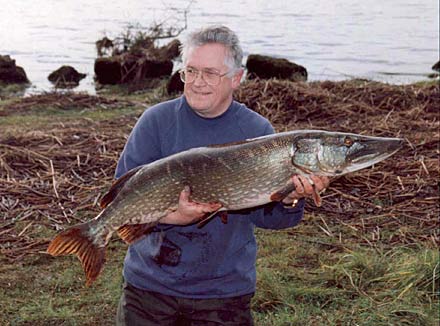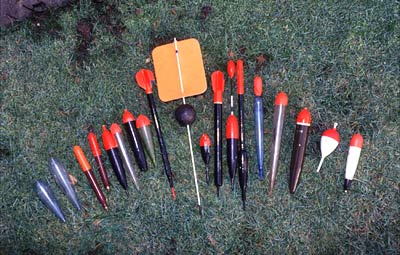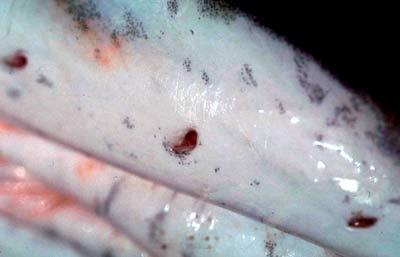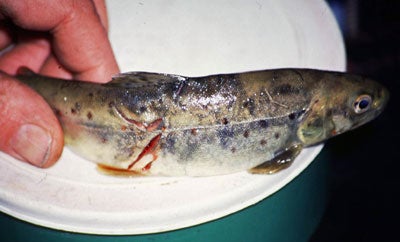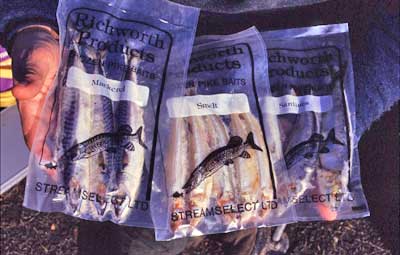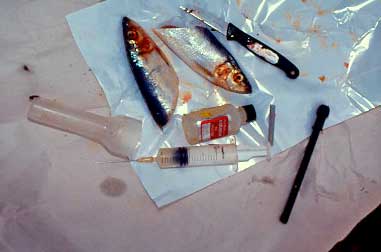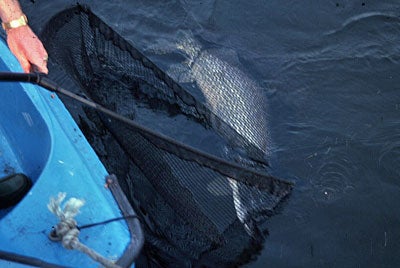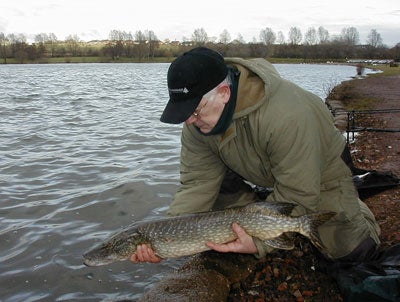Heavy lines and wire traces do not equal crudeTHERE ARE DAYS when pike can be incredibly easy to catch, as there are such days with every species. Unfortunately, when pike are feeding ravenously they invariably make it known, often in spectacular fashion, and this leads to many anglers thinking that pike are always easy.
We know pike are feeding when they strike close to the surface, when small fish leap through the surface, fighting for their lives. We see keepnets suddenly developing a life of their own as a marauding pike strives to get at the fish inside it. And the sign of feeding pike we all know only too well, when the small fish we are playing suddenly becomes a big fish as it is grabbed on the way in. Many non-pikers reckon they spend too much time trying to avoid the attentions of pike (a la Bob Nudd). Certainly, it must seem that way when they lose yet another fish and hooklength before the prey reaches the safety of the landing net. To the non-pike angler it must suggest that pike are always much easier to catch than any other species. Experienced pike anglers know that this is far from the truth. It is just as easy to notch up a run of blanks when fishing for pike as it is with any other species. Sadly, however, many anglers, and I would go so far as to say the majority, foster this attitude towards pike fishing even following several years of seriously fishing for them. It appears that they follow two or three basic methods, usually lure fishing, straight legered baits, or simple float suspended baits.
What are the finer points then? And I can almost hear some of you: “Finer points? Is there any such thing in pike fishing? Finer points? When 20lb and heavier wire traces are used. Sounds like a contradiction in terms to me.”
I suppose it does take a bit of accepting that a ferocious looking, generally big, tooth-infested creature like a pike can take food rather delicately, to the point where it can rival the wariest bream in the twitch-bite stakes. Yet we don’t give such a concept a second thought where other species are concerned, even though the pike, unlike other coarse fish, has a lateral line that stretches all the way to its nose, and probably is more sensitive to what goes on around it than any other freshwater species. We don’t think twice about changing a 2 1/2 lb hooklength for a 1 1/2 lb hooklength, or a 16’s for an 18’s hook when we’re fishing for roach or bream, yet how many pike anglers swap from, say, a 28lb wire trace to a 20lb trace, or size 6 trebles for 8’s trebles to get more bites? Very few that I know of. Right, the finer points. What are they in pike fishing? Accepting that pike do not always attack a bait with a display of fireworks and a run to rival Linford Christie is the first requirement. And then recognising the time has come when you generally need to be more subtle when pike fishing is the second. The first thing that was noticeable on one of the Cheshire meres I used to fish was that a fair number of pike were picking up the bait, only to drop it pretty quickly when they sensed (or remembered) that it was suspicious. Many times these pick-ups were not noticed, for lines would stay clipped up to drop-off indicators, bobbins would hardly move, and when they did those fishing off the baitrunner waited for the spool to begin revolving, which of course it never did. That’s a mistake anyhow, for even when pike are well on feed it is better to fish an open bale arm when legering, for there will always be an odd time when even the little resistance from a baitrunner will be enough to cause the fish to drop the bait. It is not like bolt-rig fishing for carp, where the baitrunner is somewhat irrelevant to the sensitivity once the carp is on the move.
Many times it was discovered a pike had picked up your bait only when you spotted the teeth marks on the bait after you reeled in for another cast, or to pack for home. So what is the answer? The answer to dropped baits can be tackled in two basic ways. The first method is to increase the sensitivity of the rig and bite indication, and the second is to offer baits that they are less wary of. Along with the first method of increasing rig and indicator sensitivity rides the fact that pike anglers have got to get it into their heads that it is totally unnecessary to allow a pike to run, or even hold the bait in its mouth, for any length of time before striking. Quite apart from the fact that any hesitation about striking a pike that has picked up the bait can result in deep hooking, the greatest risk you take otherwise is in allowing more time for the pike to reject the bait. I think this delay in between bait pick-up and striking is responsible for more lost pike than any other single reason. Logically too, if we are going to use more sensitive techniques in order to spot those pick-ups from pike that normal techniques miss, then it makes sense to immediately react to any indication of a bite. Anything less, and we may as well not bother to try and spot that moment when the pike takes the bait into its mouth, and just sit there waiting for that full-bloodied run that may never happen.
Use fresh baits First, though, make sure you use fresh baits. There is not a rig, technique, or anything else that matters if you’re offering bait that is stale. It won’t be rejected by the pike, that’s for sure, because the pike won’t accept it in the first place. If you can’t get hold of fresh-caught deadbait and, like me, have to use blast-frozen deadbaits most of the time, then buy them from a reputable company. Try bait flavours too, often they can tip the balance between a rejected bait and an accepted one. The end rig Let’s start with the end tackle of my legering set-up. I use a very simple rig comprising a 15lb main line to a 65lb Berkeley link-swivel. Above this swivel is a rubber bead, then a leger bead with a bomb attached. Two to three feet above this is a large float stop, whose purpose it is to prevent the lead from running back up the line when I cast. It does not interfere with the run from a pike for the simple reason that I have usually struck at the fish before the stop reaches the swivel. The only times I haven’t struck before then is because the run was faster than I was, and then it usually doesn’t matter anyhow, for the pike is hooked because it ran the stop fast up to the bomb. I most often use a heavy lead of at least 2oz, which may seem to you to be far from a sensitive set-up. It is though, for the reason that it provides that essential fulcrum point that forces line to be pulled through the leger bead, rather than moving the bomb, and so has more chance of registering on a bite indicator. For some time now I have been convinced that reasonably heavy leger weights offer the most sensitivity – with any rig and any species – and the free-line rig offers the least.
Hook size is important. On a really good day the pike will take size 2 hooks and think nothing of it. On a less than good day a 2’s hook can have the same effect as having a couple of Rottweilers attached to the bait. The biggest hooks I use for bait fishing are 6’s, most often I use 8’s and 10’s, and occasionally 12’s. These are micro-barbed. I flatten the barbs on my micro-barbed hooks to leave just a little bump that offers enough grip to make me feel better about it, but offers hardly any resistance when unhooking the fish. Bite indicators The most sensitive bite indicator we can use is dependent on the distance we cast. At short range a loaded float is best, but at long range we need more of the float above surface in order to see it and therefore degrade the advantage of using a float. When a loaded float is used, the rod, following casting, should be placed in two rests and the line tightened until it is fairly tight all the way to the bait, and the float is sunk almost to its tip. The moment the bait is interfered with in any way will register at the float, usually by rising through the surface, and the instant you see anything happening is the instant you should strike. Don’t give the pike any more time than necessary to eject the bait. If you have been in the habit of ‘letting a pike run’ you will be surprised at the number of fish you hook if you get into the habit of striking immediately and how many fewer pike you hook too deeply. If the range at which you need to fish inhibits the use of float-leger methods you need to look at the bite registration system you’re using on the pod or rod rests. For most applications the mercury tilt-switch type of drop-off alarm is fine, but when the fish are in a really difficult mood an extremely sensitive conventional bite alarm is better. I often use a drop-off visual indicator, which is a large, egg-shaped polyball painted fluorescent orange that incorporates an adjustable Gardner line clip and a length of cord to attach it to the pod or rod rest. For this sensitive type of application its main use is to hold the line tight. The important part now is to set the alarm at its most sensitive, and the vibration sensing alarms like the Delkim are best in this instance. Set correctly the line does not have to be plucked from the clip to register a bite. Any extra tightening, or any slackening, of the line will trigger a response. Bear in mind however that this type of indication is too sensitive when livebaiting for the bait will trigger it too often.
Hanging from the surface or coming up off the bottom? As for the use of float-suspended baits, live or dead, I much prefer, when the pike are in dour mood, to offer the bait coming up from the bottom. Use a polyball attached to a livebait, or a buoyant insert in a deadbait. Very often it is enough to insert just enough buoyant material in a deadbait to make it hover on, or very slightly off, the bottom – semi buoyant or critically balanced as modern vernacular has it. It makes it so easy then for the pike to take it. So, don’t assume that pike are not feeding at all, or not interested, the next time you’re having a bad day. Try some extra sensitivity, especially if you have evidence that they’re picking up the bait. After all, you wouldn’t just give up, or stick to your regular method if you were fishing for any other species. Would you? |
Welcome!Log into your account










